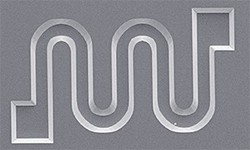The addition of a surfactant to an etching solution allows curved patterns to be cut efficiently into silicon surfaces

Fig. 1: Scanning electron microscopy image of a curved microfluidic channel formed on a silicon surface by adding surfactant molecules to a wet etchant solution.
In the multi-billion-dollar microelectromechanical system (MEMS) industry, silicon plays a starring role. Silicon's unique chemical and material properties enable it to be carved into intricate and durable shapes for use as membranes, cantilevers, needles and nozzles, at dimensions smaller than a hair's width. Many essential technologies, ranging from car airbags to advanced medical sensors, rely on silicon-based MEMS devices for their functionality.
One of the most important processes in micro-scale silicon fabrication is wet etching: using liquid chemicals, such as tetramethylammonium hydroxide (TMAH) solutions, to selectively dissolve atoms on a silicon surface. After covering the area to remain intact with a lithographic mask, wet etchants are used to cut complex patterns into the silicon crystal. The technique is a significant time and money saver for industry.
However, because wet etching generally progresses by etching away silicon atoms from flat crystallographic planes of the crystal, certain shapes, such as curved profiles, are notoriously hard to produce. Now, Kazuo Sato and colleagues from the Nagoya University GCOE for Micro-Mechatronics have developed a method to overcome this problem1. Using the interaction of silicon with a surfactant called Triton during TMAH etching, the researchers were able to fabricate micro-scale rounded shapes and curved corners with ease -- setting the stage for a new generation of MEMS structures.
To make this breakthrough, Sato and his team used extensive in situ analytical techniques to study how the Triton surfactant affects the TMAH etching of silicon. They found that on silicon crystal faces that are strongly water-repellent (hydrophobic), specifically the {111} and {110} faces, Triton suppressed the etching rates markedly; on less hydrophobic surfaces ({100}), the surfactant had almost no effect. Experiments revealed that the changes in etching behavior correspond to the density of Triton molecules on the silicon surface, with higher coverage on the slow-etching, hydrophobic surfaces.
In conventional wet etching, curved shapes are often undercut -- silicon atoms are removed from beneath the protective lithographic mask. Triton adsorption, however, slowed the silicon etching rate and almost completely eliminated undercutting. Sato explains that the combination of Triton and TMAH inhibits etching on several families of crystallographic planes, making it possible to fabricate the curved patterns needed for MEMS applications such as microfluidic channels (Fig. 1).
Sato notes that the striking geometries that are possible using wet etching continue to inspire his research into innovative MEMS technologies. "The beauty of these etched profiles, which reflect the underlying silicon crystal structure, has captivated me since I started my research in this area in the mid-1980s -- and it still does today," he says.
Affiliated Researchers
The Nagoya University affiliated researchers mentioned in this highlight are from the Education and Research of Micro-Nano Mechatronics GCOE program (μ-Mech) of the Department of Micro-Nano Systems Engineering.
Reference
- Pal, P., Sato, K., Gosalvez, M. A., Kimura, Y., Ishibashi, K.-I., Niwano, M., Hida, H., Tang, B. & Itoh, S. Surfactant adsorption on single-crystal silicon surfaces in TMAH solution: Orientation-dependent adsorption detected by in situ infrared spectroscopy. Journal of Microelectromechanical Systems 18, 1345-1356 (2009). | article